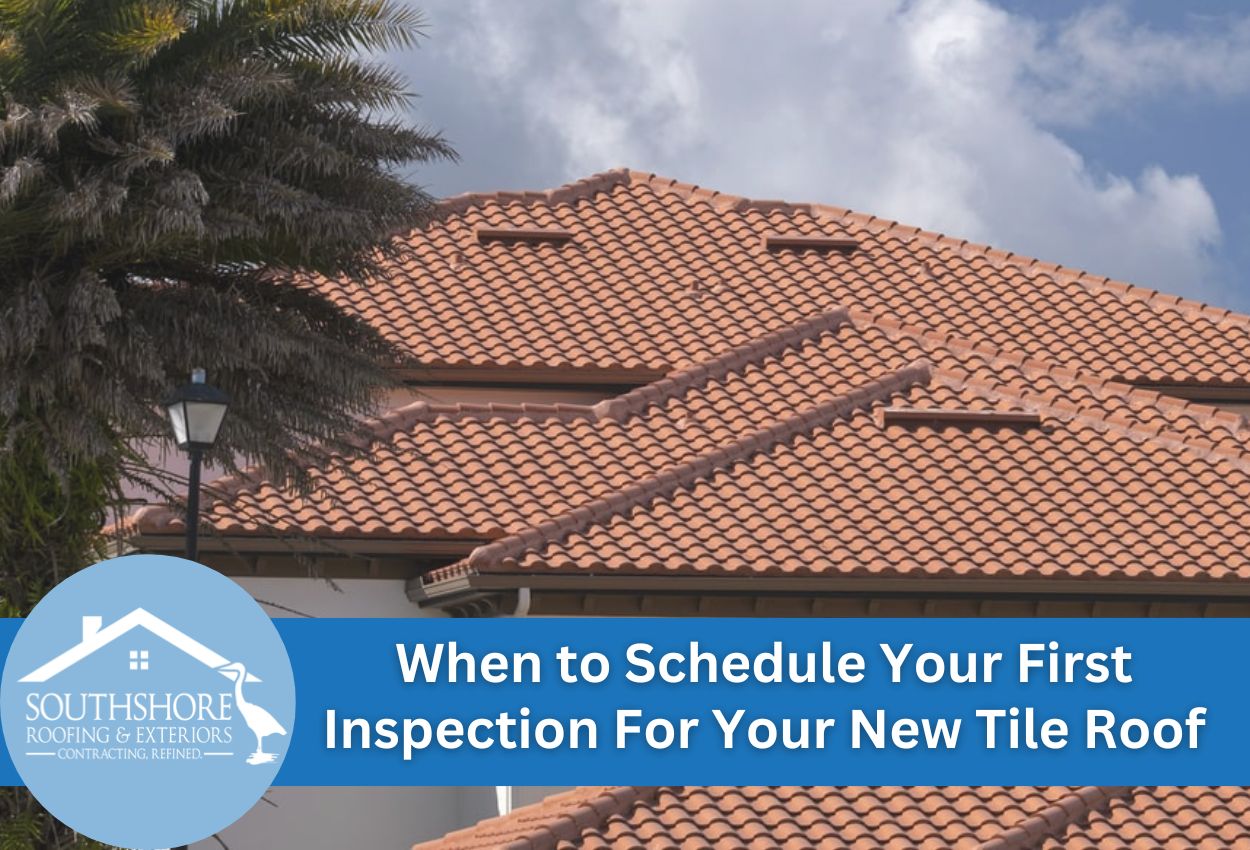A new tile roof represents a significant investment in your home’s protection and value, especially in Tampa’s challenging climate. Knowing when to schedule that first post-installation inspection is crucial for ensuring your roof’s longevity and performance. Most roofing professionals recommend scheduling your first inspection within 6 to 12 months after installation, rather than waiting for visible problems to develop.
Tampa’s unique weather conditions — including intense sun, heavy rains, and occasional severe storms — make inspections even more critical for tile roofs. The first maintenance check establishes a baseline for your roof’s condition and helps create a customized maintenance schedule based on your specific roofing system and local environment.
By understanding the point of creating, and following, a post-installation roof inspection scheduling process, homeowners can protect their investment and potentially add years to their roof’s service life. This initial roof assessment after installation also provides peace of mind that your new tile roof is properly positioned to withstand Florida’s demanding weather conditions.
Post-Installation Inspection: The 30-Day Checkup
The 30-day mark represents an ideal time for your first post-installation roof inspection. This timing provides the perfect balance, which allows your new tile roof to settle naturally while still catching any early installation issues before they develop into serious problems. After about a month, the roofing materials have had sufficient exposure to Tampa’s weather conditions, revealing potential weaknesses while still being early enough to address them under most contractor workmanship guarantees.
During this initial assessment, our Tampa roofing professionals look for several common post-installation problems specific to Florida tile roofs. These problems include improper tile alignment that can lead to water intrusion, fastener issues that may arise from early expansion and contraction cycles, and flashing problems that only become apparent after rainy events. Our experts also inspect for proper attic ventilation performance, as the first month often reveals whether the system can manage Florida’s intense heat and humidity.
Other inspection points include examining how the underlayment is performing, checking for any displaced tiles from recent weather, and ensuring water is flowing correctly through your drainage system. This 30-day checkup often serves as a crucial early warning system, allowing us to make minor adjustments that prevent major repairs later. Many homeowners find that this initial roof assessment after installation provides valuable peace of mind and helps establish a baseline for future maintenance needs.
Weather-Related Timing Considerations for Tampa Homeowners
Tampa’s unique climate creates special considerations when scheduling that first inspection for your new tile roof. Florida’s hurricane season, which runs from June through November, should significantly influence your inspection timing decisions. Ideally, schedule your first inspection before hurricane season begins, allowing professionals to identify and address any vulnerabilities before severe weather strikes. This proactive approach is particularly important for new tile roofs that have yet to experience extreme weather conditions.
The intense Florida sun presents another timing consideration. Ultraviolet radiation can accelerate the aging process of roofing materials, potentially causing issues like tile cracking or underlayment deterioration. During summer months when UV exposure is at its highest, it’s wise to have more frequent inspections, especially if your roof receives direct sunlight throughout the day without shade from trees.
Tampa’s rainy season brings additional challenges. Heavy downpours can reveal leaks or drainage issues that might remain hidden during dry periods. Scheduling your new tile roof inspection after several rainfall events, but before the heaviest rain months, provides optimal insight into how your roofing system handles moisture.
Remember that severe weather events override your regular inspection schedule. If your area experiences a hurricane, tropical storm, or unusually severe thunderstorm, don’t wait till it’s been 30 days to plan your first inspection — schedule an emergency assessment immediately.
Warranty Protection: An Inspection Requirement You Can’t Ignore
Many homeowners don’t realize that their beautiful new tile roof comes with specific warranty requirements that can’t be overlooked. Most manufacturer warranties for tile roofing materials include mandatory inspection schedules that must be followed to maintain valid warranty coverage. Typically, these warranties require a professional inspection within the first 12 to 24 months after installation, with documentation submitted to the warranty provider. Failing to complete these inspections often voids your warranty protection, potentially leaving you financially vulnerable if problems develop.
Your contractor’s workmanship warranty carries similar requirements. These warranties generally mandate at least one post-installation inspection during the first year to verify proper installation techniques and materials. Tampa roofing professionals recommend scheduling these warranty-required inspections as soon as possible rather than pushing deadlines, as weather damage can occur unexpectedly in Florida’s climate.
Proper documentation from your first inspection serves as crucial protection for future warranty claims. After your initial new tile roof inspection, be sure to maintain detailed records including:
- Dated inspection reports,
- Photographs of the roof’s condition,
- Certification that the roof meets the manufacturer’s specifications
- Documentation of any minor repairs or adjustments made
This paperwork will serve as evidence that establishes your compliance with warranty terms while creating a comparative baseline for tracking your roof’s condition over time.
DIY Assessment vs. Professional Inspection: When Each Makes Sense
While professional inspections are essential for your new tile roof, homeowners can and should perform basic visual assessments between professional visits. During the first weeks after installation, walk around your property and look for obvious issues like displaced tiles, debris accumulation, or water staining along the roof valleys. Check inside your attic on a sunny day — light that’s seeping through the roof deck indicates potential gaps that require immediate attention.
DIY assessments are appropriate for routine monitoring but cannot replace professional inspections. Tampa homeowners should perform these visual checks monthly during the first year and especially after significant weather events. Document any observations with dated photos to share with professionals later.
However, certain signs may require you to push the inspection timeframe up. Contact a qualified Tampa roofing professional immediately if you notice:
- Interior water stains on ceilings or walls,
- Cracked or broken tiles
- Sagging roof sections
- Unexplained increases in energy bills
- Flashing damage
These symptoms suggest potential problems requiring expert evaluation.
Professional inspections offer what DIY assessments cannot — comprehensive evaluation using specialized equipment and trained eyes that recognize subtle warning signs. While homeowner vigilance provides valuable early warning, only professional roofers can properly assess underlayment condition, flashing integrity, and structural components supporting your tile roofing system.
Creating a Complete Roof Maintenance Calendar
Planning ongoing maintenance for your tile roof is essential for maximizing its lifespan in Tampa’s challenging climate. After your initial post-installation inspection, you’ll need a structured maintenance calendar to keep your roof in good condition year after year. Professional roofing contractors recommend developing a customized schedule based on the specific characteristics of your tile roof that also takes into account factors like tree coverage, exposure direction, and your home’s microclimate within the Tampa area.
Your maintenance calendar should include quarterly visual assessments you can perform yourself, plus professional inspections at least once a year. Document each inspection with photos and notes to track changes over time. These records become valuable for warranty purposes and to help identify slowly developing issues before they cause significant damage. Most Tampa homeowners find that scheduling professional inspections during the spring months provides an opportunity to address any winter damage before hurricane season arrives.
The first year of your tile roof requires special attention. After your initial post-installation inspection, schedule follow-up professional assessments at the six and one-year marks. This intensive first-year monitoring establishes a solid baseline and catches any installation-related issues during the warranty period. Your tile roof inspection timeline can then transition to a regular annual or semi-annual schedule based on your roof’s performance and local environmental factors.
Selecting a Qualified Inspector for Your New Tile Roof
Finding the right professional to inspect your newly installed tile roof is crucial for protecting your investment. In the Tampa area, where weather conditions can be particularly challenging for roofing systems, working with a qualified inspector becomes even more important. Look for professionals who hold specific tile roofing certifications and have extensive experience with the particular type of tile used on your home. The best inspectors will have credentials from organizations like the Tile Roofing Industry Alliance or similar roofing associations that focus on continuing education.
When interviewing potential inspectors, ask detailed questions about their familiarity with the specific tile used on your home. Concrete, clay, and composite tiles each have unique characteristics and potential issues that require specialized knowledge. Request information about their inspection process — comprehensive evaluations should include examining the underlayment, flashing, ventilation systems, and structural supports in addition to the tiles themselves. A thorough new tile roof inspection should take several hours, not minutes.
Ask candidates to explain their documentation methods. Professional inspectors should provide detailed written reports with photographs highlighting any areas of concern. They should be able to explain how their inspection satisfies your warranty requirements and whether they can submit necessary documentation directly to manufacturers if needed. The post-installation roof inspection process should also include clear recommendations for any maintenance needs in the future and suggest a timeline for future inspections.
Ensure The Longevity of Your New Tile Roof with SouthShore Roofing & Exteriors
Understanding when to schedule the first inspection for your new tile roof is crucial, especially in Tampa, Florida. At SouthShore Roofing & Exteriors, we recommend not delaying your initial roof inspection. Early assessment by professionals helps detect any minor issues that could turn into expensive repairs later. This proactive approach not only extends the lifespan of your roof but also ensures that your warranty remains valid.
Don’t wait for the first signs of trouble! Give your tile roof the best start with a thorough inspection from the experts. Call SouthShore Roofing & Exteriors today at (813) 400-3329 to schedule your first inspection and secure the peace of mind that comes with knowing your roof is built to last.




